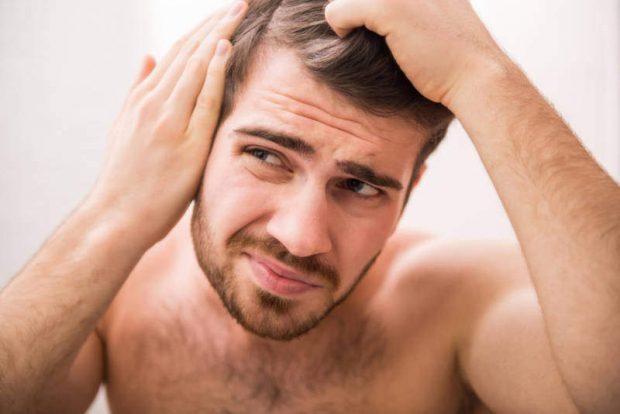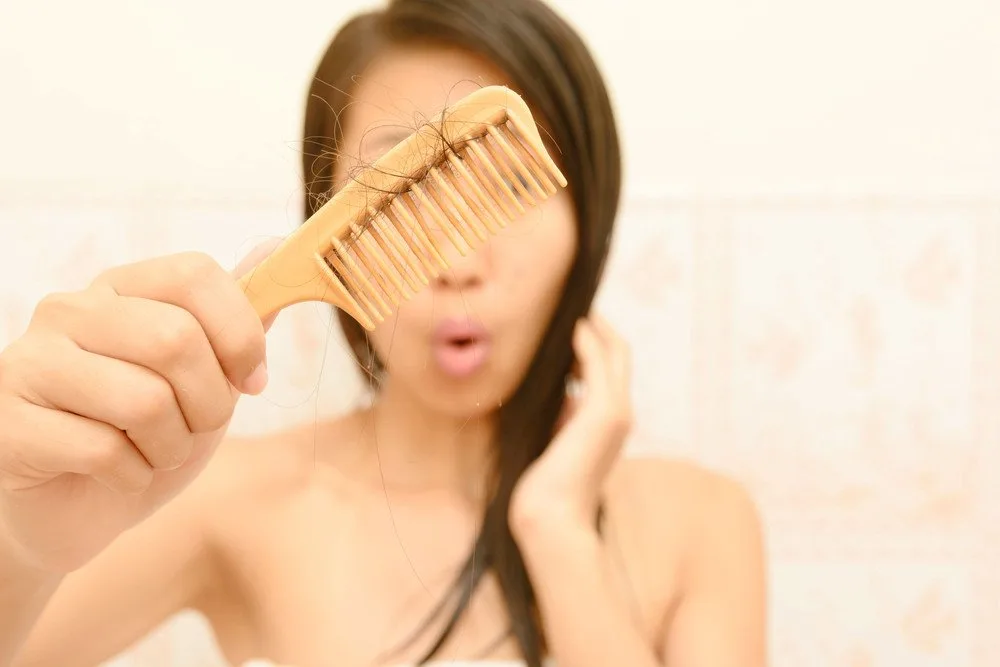Androgenic alopecia, also known as male or female pattern hair loss, is the primary cause of the notorious receding hairline among men and women. Some simply view the condition as an issue of vanity. However, the emotional effects of balding are adverse to the individual affected by the condition. It’s a common misconception to assume the phenomenon of the androgenic alopecia in combination with the stigma surrounding it, is a modern problem. On the contrary, humans have had to deal with the ordeal along with its emotional effects for thousands of years.
This age-old conundrum continues to threaten our self-confidence. Yet somehow, we have yet to find the ultimate solution. So why the delay? The condition’s complex molecular mechanism is to blame. So, without further ado, below, we’ll discuss the characteristics of androgenic alopecia and the currently most effective treatments for it.
What is androgenic alopecia?
Androgenic alopecia is a condition that upon binding to androgens activates a cascade of cellular activity that ends with the miniaturization of follicular units on the scalp.
The genetics of androgenic alopecia
The condition is entirely a matter of genetics, and the X chromosome is the villain. With years of myths regarding androgenic alopecia, the truth is finally surfacing, and our understanding of the condition is almost complete. An inherited x-linked condition may be to blame for this form of hair loss.
The varying degrees of the condition from one individual to another is the result of versatile genes. These genes play a role in the mechanism of male pattern hair loss.
What are DHT receptors?
Follicular units could either be androgen-sensitive or androgen insensitive. An individual’s genetic information contains the ratio of one property to the other. Androgen sensitivity is a property encoded within the X-chromosome adapting androgen-sensitive follicular units to have more DHT receptors. DHT is a more aggressive version of testosterone that triggers the dormancy of follicular units. Due to the increased numbers of DHT receptors, androgen-sensitive follicular units are victims of the augmented adverse effects of DHT. Androgen resistant follicular units, therefore, have fewer androgen receptors and are not susceptible to the harmful effects of DHT. Generally, the hair on the back of the scalp tends to be androgen resistant, and as we move toward the crown and closer to the hairline the higher the odds of follicular units to possess polar opposite properties.

One mysterious aspect of the condition that is creating an obstacle for the discovery of a permanent cure is the contradicting effects of DHT on follicular units. Where the hormone is a source of destruction for follicular units in the scalp, its effects are constructive on body follicular units. How and why the same hormone has different consequences on follicular units based on location, remains a puzzle.
In summary, the well-known fact that mothers are to blame for their sons’ receding hairline is not false. Men inherit their baldness from their mothers.
Male androgenic alopecia vs female androgenic alopecia
Although the condition progresses similarly, the two are relatively different. In male-pattern hair loss, the hairline recedes in a predictable pattern. Initiating first as an M shape, it could recede all the way back to form a U-shape pattern of hair loss. Hair loss in female pattern hair loss is more diffuse and has no pattern.
Treating androgenic alopecia
The treatment plan for androgenic alopecia varies according to the progression of the condition. The miniaturization of follicular units is permanent. Therefore, treating this form of hair loss follows a different approach to treating a less advanced form of hair loss.
Non-advanced androgenic alopecia treatments
1- Minoxidil
Minoxidil is one of two FDA approved hair loss treatments. The medication comes in a solution form or as a serum. For men, a 5% minoxidil solution is advised, whereas women should opt for the 2% minoxidil solution.
Researchers aren’t entirely sure of how minoxidil manages to reverse hair loss. However, they believe it has something to do with the solution encouraging circulation in the follicular units. This then, consequently, promotes hair growth.
Minoxidil may lead to an increase in body hair. So there are times whereby women are given a more diluted version.
To maintain the results, patients have to apply the serum twice daily incessantly. If the patient decides to stop using Minoxidil, they can expect the hair loss to continue within a month.
2- Finasteride
Finasteride is another FDA approved hair loss treatment. The remedy comes in the form of a pill that disables the enzymatic abilities of the 5-alpha-reductase enzyme responsible for catalyzing the conversion process of testosterone to the aggressive version of DHT.
It’s important that patients take the medication on a daily basis. Some of the side effects of finasteride include erectile dysfunction in men.
3- PRP therapy
PRP therapy is an emerging treatment for hair loss. Although it is waiting for the seal of approval from the FDA, various experiments have proved its success in reversing androgenic alopecia in advanced and non-advanced cases.
PRP therapy is short for platelet-rich Plasma therapy. As the name suggests, the technique utilizes platelet-rich Plasma to reverse the effects of DHT. Researchers found that certain growth factors, such as VEGF, helped to counteract hair loss. Platelet-rich plasma is a reservoir of various growth factors.

First, blood is drawn from the patient and centrifuged. This is a process whereby the platelet-rich plasma is separated from the remaining components of the blood. This extract is then later injected into the scalp. The hope is that the growth factors will act as extracellular signaling molecules that promote proliferation within follicular units. Patients could need anywhere between one to eight monthly sessions per year, depending on the individual variety. The following article describes the mechanism of PRP therapy.
Advanced hair loss treatment
Advanced hair loss occurs once follicular units miniaturize. If a patient is battling with this, the best approach would be hair transplantation.
Hair transplantation is a surgical procedure. It can either be minimally invasive or invasive, depending on the patient’s chosen technique. Androgen resistance is inherited so hair transplants are the silver lining for the bald. The androgen insensitive follicular units are extracted from areas of hair growth and relocated to areas of hair loss where they promote hair growth permanently.
Different types of hair transplants
1- Follicular unit transplantation (FUT)
Follicular unit transplantation is one of the oldest techniques of hair transplantation and the least practical as well. In order to obtain androgen resistant follicular units, FUT requires the incision of an entire strip of skin from the scalp. The piece is then dissected carefully under a microscope and separated according to the number of hairs per follicular unit. The follicular units with fewer hairs are implanted near the hairline, whereas the ones with more hairs are distributed around the crown.
The technique of graft harvesting in follicular units results in a deep wound that heals into a visible scar. In addition, the depth of the incision inflicts nerve damage in an area that could either be temporary or permanent.
2- Follicular unit extraction (FUE)
FUE soon emerged to revolutionize the hair transplant industry.
Follicular unit extraction is a technology that individually harvests follicular units. With a micro-punch, the grafts are first isolated via creating micro incisions around them and are then extracted using forceps. The minimally invasive nature of the extraction procedure in FUE yields immaculate scar-free results with no nerve damage. The follicular units are then implanted in areas of hair loss where they generate permanent growth.
3- Sapphire FUE
Sapphire FUE is a variant of the traditional FUE that enhances the remaining procedures of the process aside from the extraction phase. The grafts are extracted using FUE. However, in the implantation phase, sapphire FUE aims for more precision and better results.
To implant the extracted follicular units, sapphire FUE Technique utilizes blades made of sapphire stone to create the incisions on the recipient site which in turn gravely impacts the results. For one, Sapphire blades have more of a V-shaped ending as opposed to the traditional U-shaped top of steel blades. Moreover, sapphire blades are transparent hence allowing the surgeon to observe the process from various perspectives carefully.
Sapphire FUE does not impose any risks on neighboring tissue. This provides two important aspects.
- The compact incisions made result in much more natural-looking results.
- The incisions are a lot more precise.
 Are hair transplants for everyone?
Are hair transplants for everyone?
The short answer is, not really. Females battling with pattern hair loss cannot look at hair transplants. This is because locations androgen resistant follicular units could prove to be quite challenging. In addition to female pattern hair loss, factors such as sufficiency and the donor’s hair could be an obstacle.
Since the donor’s hair is not renewable, patients need to have a sufficient supply that could cover balding scalp while preserving the appearance of the donor region. Otherwise, patients are not eligible for hair transplantation.
If you would like to have your scalp examined by a medical specialist, you need to consult a professional hair transplant center that offers free online consultation sessions for patients to have their scalps assessed and concerns addressed.
In closing
Hair loss is an issue that has terrorized humanity since the start of dawn. Although there is no shame in hair loss, many struggle to accept the phenomenon. In which case, the remedies are versatile enough to stitch back your confidence. Men can blame their mothers whereas, for women, the situation is a lot more ambiguous.
If you suffer non-advanced hair loss, minoxidil, finasteride, or PRP therapy can effectively reverse your dilemma. On the other hand, if the condition has progressed past miniaturization, you should consider hair transplantation. The results of the micro-surgery depend entirely on the technique you opt for. Therefore, it’s important to choose wisely.
If you need to find out more about hair transplants and professional services from Vera Clinics click here:



 Are hair transplants for everyone?
Are hair transplants for everyone? ![women [longevity live]](https://longevitylive.com/wp-content/uploads/2020/01/photo-of-women-walking-down-the-street-1116984-100x100.jpg)










